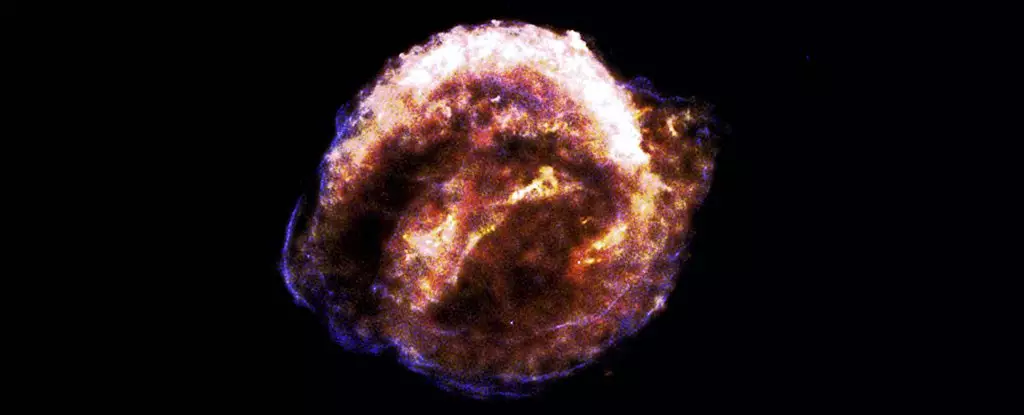In the grand tapestry of our universe, the violent death of massive stars manifests as supernovae, unleashing unimaginable energy and forging crucial elements like iron. Interestingly, some isotopes of iron, specifically Fe60, have been found in the sediments of Earth’s ocean floors, suggesting that these stellar explosions have left their mark not just on cosmic scales but directly on our planet. Recent research, highlighted in the Astrophysical Journal Letters and authored by astrophysicist Caitlyn Nojiri and her team, probes the implications of these energetic events on biological processes on Earth. Their investigations hint at a striking correlation between supernova activity and significant shifts in the evolution of terrestrial life.
The study reveals that Earth has encountered two distinct accumulations of Fe60 isotopes, dated roughly two to three million years and five to six million years ago, respectively. The younger accumulation correlates directly with a supernova explosion, while the older one aligns with the Solar System’s passage through what is known as the Local Bubble—a region in the interstellar medium shaped by the outflows from numerous OB stars. These massive stars, characterized by their hot temperatures and rapid lifecycles, produce powerful stellar winds, creating expansive “bubbles” of hot gas. Our Solar System has resided within the Local Bubble for several million years, a phenomenon that has profound implications for the radiation levels encountered on Earth.
Cosmic radiation, as the authors note, is a constant presence in the environment, differentiating itself from terrestrial radiation. While terrestrial radiation has gradually diminished over billions of years, cosmic radiation fluctuates based on Earth’s trajectory through space. The immediate concern arises from the potential for increased radiation levels due to nearby supernova explosions. According to the research, these events could amplify radiation on the surface of the planet significantly, potentially affecting biological processes and the evolutionary trajectory of life.
The research claims that as many as nine supernovae have exploded in our vicinity over roughly the last six million years, creating a dynamic and energetic environment within the Local Bubble. The implications of these energetic events resonate throughout the course of biological evolution on Earth, raising critical questions about how varying levels of cosmic radiation impact life.
One of the more intriguing aspects discussed in the research involves the biological consequences of exposure to heightened cosmic radiation levels. The authors explore the possibility that increased radiation could lead to double-strand breaks in DNA, a form of severe genetic damage with implications for mutation and genetic diversity. They hypothesize that as cosmic events alter radiation levels, the evolutionary landscape could shift, leading to potential spurts in biodiversity.
An exciting link between supernova radiation and historical biological evolution arises from a previous study indicating that the diversification of viruses in Africa’s Lake Tanganyika appeared to accelerate during the same period as the younger Fe60 accumulation. This raises compelling deliberations about whether supernova radiation could be an underlying factor contributing to evolutionary developments during that timeframe.
As the researchers articulate, while supernova-generated radiation does not appear to be potent enough to trigger mass extinctions, it may play a crucial role in fostering genetic mutations that enhance species diversification. The implications are clear: cosmic radiation is an omnipresent environmental factor that must be integrated into any assessment of life’s viability and evolution.
Yet, the complexities of how radiation interacts with biology remain inadequately understood. The threshold at which radiation acts as a creative or destructive force in evolution is still largely vague, necessitating further investigation into the biological effects of cosmic phenomena, especially the muons predominating at the Earth’s surface.
The findings underscore the idea that cosmic events—while often perceived as detached and remote—are intricately woven into the fabric of terrestrial life. Supernovae, through their radiation and elemental contributions, could have played a crucial role in shaping evolution as we know it. As we delve deeper into the cosmos, we unveil not just the mysteries of distant stars but also the influence their glorious phenomena exert on life here on Earth. The strands connecting stellar events to our biological heritage remind us of the intricate balance and synchronicity in nature that made it possible for us to exist today. Without the monumental power of supernovae, the evolutionary path may have been strikingly different, illustrating the profound interdependence between the cosmos and terrestrial life.


Leave a Reply